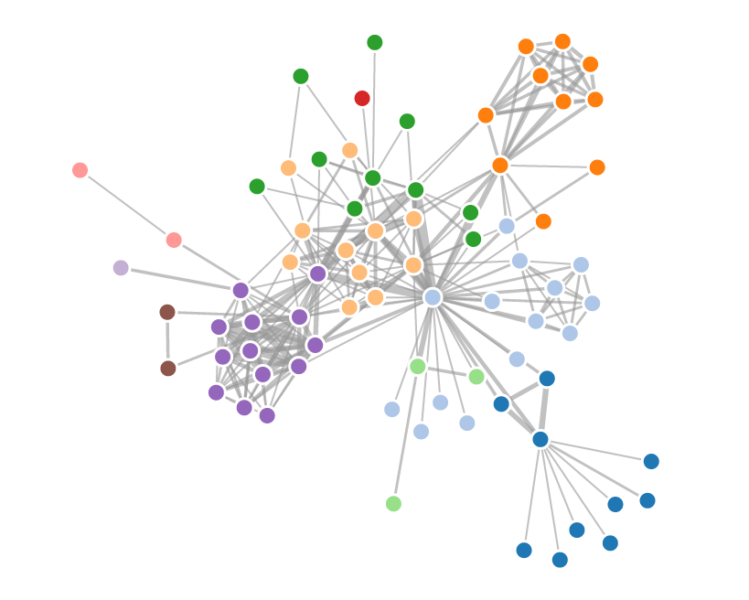Social scientists working to study modern society have an array of data sources available, from government censuses to digital social networks. But for researchers trying to study people who lived, say, 2500 years BFB (before Facebook), trying to figure out who was friends (or business associates, of family members, or political allies) with whom can pose significant challenges.
Enter “prosopography,” the practice of gaining insights into individuals based on attributes of their families, business associates, or other affiliates, based on information preserved in historic documentation. Prosopography has long been an important tool for the study of all kinds of past societies; the name stems from the Greek prosopoeia, or “face created,” suggesting how this methodology enables researchers to “put a face on” individuals about whom little is known based on information about their connections to other people.
For Laurie Pearce, lecturer in Near Eastern Studies at UC Berkeley, prosopography has been a crucial resource for understanding the relationships among elite individuals in ancient Mesopotamia. Pearce’s research entails using approximately 700 clay tablets written in cuneiform script to tease out the lives of people who lived in southern Iraq during the fourth century BC; many of these texts detail real estate transactions or small transfers of income. “It’s a challenge, because people were usually named after their fathers or grandfathers, so they had names like, ‘Joe Son-of-Fred Son-of-Joe Son-of-Fred’,” she explains. “Straightening out who lived where and when, and what they did, is a non-trivial problem.”
Pearce has been working together with Patrick Schmitz, Berkeley’s Associate Director for Research IT and Strategy, to establish Berkeley Prosopography Services, or BPS, which has created an XML-based tool to help map out relationships and discern individuals from each other. “The texts that I work on seemed like a good demonstrator corpus to explore a set of tools for a common research problem: that is, identifying individuals mentioned in text of any sort and trying to establish the social networks in which those individuals appear,” Pearce explains.
The BPS tool applies methods from the fields of natural language processing (NLP) and social network analysis (SNA) to extract the names and basic familial relationships of people mentioned in texts, and weigh the probabilities that individuals were connected to each other. The resulting graph model can be used to produce reports and visualizations ranging from simple name lists and family trees to interactive models. “There is a lot of uncertainty in these historical records,” Schmitz says. “The tool can represent that uncertainty explicitly. We can say, it is 70 percent certain that this name corresponds to this person, but it could also be one of these three people.”
Once you know who was working with whom—for example, who was in the same location at the same time—you can see how ideas might have spread and become more accepted in the community.
To further refine this tool, Pearce and Schmitz are working with the UC Berkeley Social Science Matrix to coordinate a seminar focused on exploring how historical social networks might be used by researchers working in different domains. “Prosopography has traditionally been used in the humanities, but it became clear to us that social scientists and some natural scientists are facing similar challenges of disambiguation and understanding relationships,” Pearce explains. “In the Matrix seminar, we’d like to explore how our approach and tools might benefit them. The point is not just to get together people from Near Eastern Studies who want to do this; it’s to say, what can we learn from other disciplines? We are specifically searching for people who want to understand how they would use a tool like this.”
As an example of a broader application, BPS has potential to help staff members from Berkeley’s Museum of Vertebrate Zoology, who are sifting through 100+ year-old records of the activities of collectors and researchers. “They’re trying to understand how those people related to one another, and how they collaborated,” Schmitz says. “They are facing issues … that make the identification of some of the people involved non-obvious. There’s so much data in all the thousands of records, it takes an effort to come to grips with, what were the patterns of collaboration and influence among these people?”
The power of prosopography, Schmitz explains, is that it can use these data sets to generate insights into bigger questions. “Researchers can use the network analysis to say, what are all the patterns of interaction? Who are the subgroups? Who had the most influence?” he says. “Once you know who was working with whom—for example, who was in the same location at the same time—you can see how ideas might have spread and become more accepted in the community. It has implications far beyond just mapping out a tree; it’s looking at the construction of knowledge within institutions.”
Berkeley Prosopography Services was recently awarded an NEH Digital Humanities Implementation Grant that will support this work for a two-year period. Schmitz will serve as the technical lead, and Niek Veldhuis (professor in Near Eastern Studies) will join Pearce as co-principal investigator (PI).
For more information, see the home page of Berkeley Prosopography Service, or read a research paper by Schmitz and Pearce.

